Millard Fillmore
| Millard Fillmore | |
|---|---|
 | |
| 13th President of the United States | |
|
In office July 9, 1850 – March 4, 1853 | |
| Vice President | None |
| Preceded by | Zachary Taylor |
| Succeeded by | Franklin Pierce |
| 12th Vice President of the United States | |
|
In office March 4, 1849 – July 9, 1850 | |
| President | Zachary Taylor |
| Preceded by | George M. Dallas |
| Succeeded by | William R. King |
| Member of the U.S. House of Representatives from New York's 32nd district | |
|
In office March 4, 1837 – March 3, 1843 | |
| Preceded by | Thomas C. Love |
| Succeeded by | William A. Moseley |
|
In office March 4, 1833 – March 3, 1835 | |
| Preceded by | Seat established |
| Succeeded by | Thomas C. Love |
| Chairman of the House Ways and Means Committee | |
|
In office March 4, 1841 – March 3, 1843 | |
| Preceded by | John Winston Jones |
| Succeeded by | James I. McKay |
| 14th Comptroller of New York | |
|
In office January 1, 1848 – February 20, 1849 | |
| Governor |
John Young Hamilton Fish |
| Preceded by | Azariah Cutting Flagg |
| Succeeded by | Washington Hunt |
| Personal details | |
| Born |
January 7, 1800 Moravia, New York, U.S. |
| Died |
March 8, 1874 (aged 74) Buffalo, New York, U.S. |
| Resting place |
Forest Lawn Cemetery Buffalo, New York |
| Political party |
|
| Spouse(s) |
|
| Children | Millard and Mary |
| Profession | Lawyer |
| Signature |
|
| Military service | |
| Allegiance |
|
| Years of service |
1820s-1830s (militia) 1860s-1870s (guard) |
| Rank |
Major (militia) Captain (guard) |
| Unit |
New York Militia New York Guard |
| Commands | Union Continentals (New York Guard) |
| Battles/wars | American Civil War |
Millard Fillmore (January 7, 1800 – March 8, 1874) was the 13th President of the United States (1850–1853), the last to be a member of the Whig Party while in the White House. A former congressman from New York, Fillmore had been elected Vice President in 1848, and was elevated to the presidency by the unexpected death of Zachary Taylor. Fillmore was instrumental in getting the Compromise of 1850 passed, a bargain that led to a brief truce in the battle over slavery. Fillmore failed to gain the Whig presidential nomination in 1852, and was the unsuccessful candidate of the nativist Know Nothing Party in 1856.
Fillmore was born into deep poverty in the Finger Lakes area of New York state; his parents were farmers. He bettered himself through learning, becoming a lawyer though he had little formal education. He became prominent in the Buffalo area both as an attorney and as a politician, gaining election to the New York Assembly in 1828, and to the U.S. House of Representatives in 1832. Initially, he was of the Anti-Masonic Party but gravitated to the Whigs as that party formed in the mid-1830s, and was a rival for state party leadership with editor Thurlow Weed and his protégé, William H. Seward. Fillmore was an unsuccessful candidate for Speaker of the House when the Whigs took control in 1841, but was made Ways and Means chairman. Defeated in bids for the Whig nomination for vice president in 1844, and for New York governor the same year, Fillmore was voted Comptroller of New York in 1847, the first to hold that post by election. Through his career, Fillmore decried slavery as an evil, but one beyond the powers of government, in contrast to Seward, who was openly hostile towards that practice.
Fillmore's political friends got him the vice presidential nomination in 1848 as Taylor's running mate, and the two were elected. He was largely ignored by Taylor as federal jobs were handed out, who instead consulted Seward. In his function as president of the Senate, Fillmore presided over angry debates as Congress decided whether to allow slavery in the Mexican Cession. Fillmore supported Henry Clay's bill (the basis of the 1850 Compromise) though Taylor did not. President Taylor died in July 1850, and Fillmore dismissed the cabinet and changed the administration's policy. The new president exerted pressure to gain the passage of the Compromise, which was enacted by September. The Fugitive Slave Act was a controversial part of the Compromise, and Fillmore felt himself duty-bound to enforce it, though it damaged his popularity and also the Whig Party, which was torn North from South. In foreign policy, Fillmore supported U.S. Navy expeditions to open trade in Japan, opposed French designs on Hawaii, and was embarrassed by Narciso López's filibuster expeditions to Cuba. He sought election to a full term in 1852, but was passed over by the Whigs in favor of Winfield Scott.
As the Whig Party broke up after Fillmore's presidency, many of Fillmore's conservative wing of the party saw the American Party (as the Know Nothings were known) as a possible home. In his 1856 candidacy, Fillmore had little to say about immigration, instead focusing on the preservation of the Union, and finished third in the election, winning only Maryland. Fillmore was active in many Buffalo civic endeavors, helping to found the University of Buffalo and serving as its first chancellor. During the American Civil War, Fillmore denounced secession and agreed that the Union must be maintained by force if necessary, but was critical of the war policies of Abraham Lincoln. After peace was restored, he supported the Reconstruction policies of President Andrew Johnson. Obscure today, Fillmore has been praised by some for his foreign policy, but he is criticized by others for his enforcement of the Fugitive Slave Act and for his association with the Know Nothings.
Early life and career
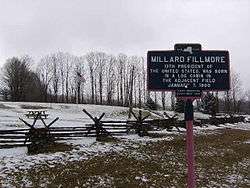
Millard Fillmore was born in a log cabin,[lower-alpha 1] on a farm in what is now Moravia, New York, Cayuga County, in the Finger Lakes region of New York state, on January 7, 1800. His parents were Phoebe (Millard) and Nathaniel Fillmore.[2] He was the second of eight children and the eldest son.[3] The Fillmores had moved from Vermont in 1799, seeking better opportunities than on Nathaniel's stone-strewn farm, but the title to the Cayuga County land proved defective, and the Fillmore family moved to nearby Sempronius,[4] where, as historian Tyler Anbinder put it, Fillmore's "childhood was one of hard work, frequent privation, and virtually no formal schooling".[2]
Nathaniel Fillmore was not a successful farmer, and hoping his oldest son would learn a trade, apprenticed him to cloth maker Benjamin Hungerford in Sparta, New York,[5] at age fourteen. Millard left due to abuse, and his father placed him in the same trade at a mill in New Hope. Seeking to better himself, Millard Fillmore bought a share in a circulating library, and read all the books he could. In 1819, he took advantage of a time of little work at the mill to enroll at a new academy in the town, where he met his fellow student, Abigail Powers, and fell in love with her.[6]
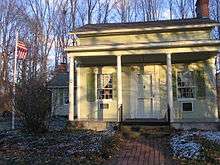
Later in 1819, Nathaniel moved the family to Montville, a hamlet of Moravia. Appreciating his eldest son's talents, Nathaniel Fillmore persuaded Judge Walter Wood, the Fillmores' landlord and the wealthiest person in the area, to allow Millard to be his law clerk for a trial period. Wood agreed to employ young Fillmore, and to supervise him as he read law. Fillmore taught school for three months to earn money to buy out his apprenticeship at the mill. But Fillmore left Wood after 18 months; the judge paid him almost nothing, and the two quarreled when Fillmore earned a small sum by advising a farmer in a minor lawsuit. Refusing to pledge not to do it again, Fillmore left, abandoning his clerkship.[7] Nathaniel Fillmore again moved the family, and Fillmore accompanied his father west to East Aurora, New York, in Erie County, near Buffalo.[8]
In 1821, Fillmore turned 21 and was thus legally independent of his father. He taught in East Aurora, and accepted a few cases in justice of the peace courts, which did not require the practitioner to be a licensed attorney. He moved to Buffalo the following year, continued his study of law (first while teaching, then in a lawyer's office), and became engaged to Abigail Powers. In 1823, he was admitted to the bar, declining offers from Buffalo law firms and returning to East Aurora as the only lawyer in town.[8][9] Later in life, Fillmore stated that he initially lacked the self-confidence to practice in Buffalo; his biographer, Paul Finkelman, suggested that after being under others' thumbs all his life, Fillmore enjoyed the independence of his East Aurora practice.[10] On February 5, 1826, Millard and Abigail wed. They had two children, Millard Powers Fillmore (1828-1889) and Mary Abigail Fillmore (1832-1854).[11]
Buffalo politician
The rise of the Anti-Masonic Party in the late 1820s attracted Fillmore. Many Anti-Masons were also opposed to the presidential candidacy of General Andrew Jackson, a Mason, and Fillmore was a delegate to a New York convention that endorsed President John Quincy Adams for re-election, as well as serving at two Anti-Masonic conventions in the summer of 1828.[2] At the conventions, Fillmore and one of the early political bosses, newspaper editor Thurlow Weed, met and impressed each other.[12] By then, Fillmore was the leading citizen in East Aurora, and successfully sought election to the New York State Assembly, serving at Albany in the legislature for three one-year terms.[2] Fillmore's 1828 election was in contrast to the victories of the Jacksonian Democrats (soon the Democrats), who swept the general to the White House and their party to a majority in Albany, thus Fillmore had to work as a member of a minority faction. He proved adept at doing so, working to get the legislature to allow court witnesses the option of affirming rather than taking a religious oath, and in 1830 gaining the abolishment of imprisonment for debt. By then, much of Fillmore's legal practice was in Buffalo and he that year moved there with his family. Although elected to the Assembly in 1830, he did not seek re-election in 1831.[13][14]
Fillmore had also experienced success as a lawyer. Buffalo was then in a period of rapid expansion, recovering from being burned by the British during the War of 1812 to becoming the western terminus of the Erie Canal. Cases from outside Erie County were already falling to Fillmore's lot, and he was prominent as a lawyer in Buffalo even before he moved there. He took Nathan K. Hall as a law clerk in East Aurora; a lifelong friend, Hall would be Fillmore's partner in Buffalo and his postmaster general as president. Buffalo had been legally a village when Fillmore came there; although the bill to incorporate it as a city passed the legislature after Fillmore had left the Assembly, he helped draw up the city charter. In addition to his successful legal practice, Fillmore helped found the Buffalo High School Association, joined the lyceum and attended the local Unitarian church, Fillmore became one of the leading citizens of Buffalo.[15] He was also active in the New York Militia, and as the inspector of the 47th Brigade, attained the rank of major.[16][17]
Congressman
Although Fillmore had retired from the legislature after the 1831 session, he did not remain absent from politics for long. In 1832, he ran for the House of Representatives, and was elected. The Anti-Masonic presidential candidate, former attorney general William Wirt, won only Vermont as President Jackson easily gained re-election. Until 1933, Congress convened its annual session in December, and so Fillmore had to wait more than a year after his election to take his seat. Fillmore, Weed, and others had realized that opposition to Masonry was too narrow a foundation on which to build a national party, and from National Republicans, Anti-Masons, and disaffected Democrats assembled the Whig Party. The Whigs were initially anti-Jackson, but became a major party by expanding their platform to include support for economic growth through rechartering the Second Bank of the United States and federally funded internal improvements including roads, bridges, and canals.[18] Weed joined the Whigs before Fillmore, and became a power within the party; his anti-slavery views were stronger than Fillmore's, and closer to those of another prominent New York Whig, William H. Seward of Auburn, who was also seen as a Weed protégé.[3]
In Washington, Fillmore urged the expansion of Buffalo harbor, a decision under federal jurisdiction, and in his private capacity served on a committee lobbying Albany for the expansion of the state-owned Erie Canal.[19] Even during the 1832 campaign, Fillmore's affiliation as an Anti-Mason had been uncertain, and he rapidly shed the label once sworn in. Fillmore came to the notice of the influential Massachusetts senator, Daniel Webster, who took the new congressman under his wing. Fillmore became a firm supporter and the close relationship between the two would continue until Webster's death late in Fillmore's presidency.[20] Despite Fillmore's support of the Second Bank as a means of national development, he did not speak in the congressional debates in which some advocated renewing its charter, despite Jackson's veto of previous legislation for a charter renewal.[21] Fillmore supported building infrastructure, voting in favor of constructing a bridge across the Potomac River and navigation improvements on the Hudson.[22]
Anti-Masonry was still strong in Western New York though it was petering out nationally, and when the Anti-Masons did not nominate him for a second term in 1834, Fillmore declined the Whig nomination, seeing that the two parties would split the anti-Jackson vote and elect the Democrat. Despite Fillmore's departure from office, he was a rival for state party leadership with Seward, the unsuccessful 1834 Whig gubernatorial candidate.[23] Fillmore spent his time out of office building his law practice and boosting the Whig Party, which gradually absorbed most of the Anti-Masons.[24] By 1836, Fillmore was confident enough of anti-Jackson unity that he accepted the Whig nomination for Congress. Democrats, led by their presidential candidate, Vice President Martin Van Buren, swept to victory nationwide and in Van Buren's home state of New York, but Western New York voted Whig and sent Fillmore back to Washington.[25]
Van Buren, faced with the economic Panic of 1837, caused in part by lack of confidence in private bank note issues after Jackson had instructed the government only to accept gold or silver, called a special session of Congress. Government money had been held in so-called "pet banks" since Jackson had withdrawn it from the Second Bank; Van Buren proposed to place funds in sub-treasuries, government depositories that would not lend money. Fillmore felt this would lock the nation's limited supply of gold money away from commerce, believing that government funds should be lent to develop the country. Van Buren's sub-treasury and other economic proposals passed, but as hard times continued, the Whigs saw an increased vote in the 1837 elections, and captured the New York Assembly. This set up a fight for the 1838 gubernatorial nomination. Fillmore supported the leading Whig vice presidential candidate from 1836, Francis Granger; Weed preferred Seward. Fillmore was embittered when Weed got the nomination for Seward, but campaigned loyally; Seward was elected, while Fillmore gained another term in the House.[26]
The rivalry between Fillmore and Seward was affected by the growing anti-slavery movement. Although Fillmore disliked slavery, he saw no reason it should be a political issue. Seward, on the other hand, was hostile to slavery and made that clear in his actions as governor, refusing to return slaves claimed by Southerners.[26] When in 1839, the Buffalo bar proposed Fillmore for the position of vice chancellor of the eighth judicial district. Seward refused, and nominated Frederick Whittlesey; in making the nomination, Seward indicated that if the state senate rejected Whittlesey, he still would not appoint Fillmore.[27]
Fillmore was active in the discussions of presidential candidates that preceded the Whig National Convention for the 1840 race. He initially supported General Winfield Scott, but really wanted to defeat Kentucky Senator Henry Clay, a slaveholder he felt could not carry New York state. Fillmore did not attend the convention, but was gratified when it nominated General William Henry Harrison for president, with former Virginia senator John Tyler his running mate.[28] Fillmore organized Western New York for Harrison, and the national ticket was elected, while Fillmore easily gained a fourth term in the House.[29]
At the urging of Senator Clay, Harrison quickly called a special session of Congress. With the Whigs to organize the House for the first time, Fillmore sought the Speakership, but it went to a Clay acolyte, John White of Kentucky.[30] Nevertheless, Fillmore was made chairman of the House Ways and Means Committee.[2] Harrison was expected to go along with anything Clay and other congressional Whig leaders proposed, but died on April 4, 1841, elevating Vice President Tyler to the presidency. Tyler, a onetime maverick Democrat, soon broke with Clay over congressional proposals for a national bank to stabilize the currency, which he vetoed twice, leading to his expulsion from the Whig Party. Fillmore remained on the fringes of that conflict, generally supporting the congressional Whig position, but his chief achievement as Ways and Means chairman was the tariff of 1842. The existing tariff did not protect manufacturing, and part of the revenue was distributed to the states, a decision made in better times that was by then depleting the Treasury. Fillmore prepared a bill raising tariff rates that was popular in the country, but the continuation of distribution assured a Tyler veto, and much political advantage for the Whigs. Once Tyler vetoed it, a House committee headed by Massachusetts' John Quincy Adams condemned his actions. Fillmore prepared a second bill, this time omitting distribution, and when it reached his desk, Tyler signed it, but in the process offended his erstwhile Democratic allies, thus Fillmore not only achieved his legislative goal, he isolated Tyler.[31]
Fillmore received praise for the tariff, but in July 1842 he announced he would not seek re-election. The Whigs nominated him anyway, but he refused it. Tired of Washington life and the conflict that had revolved around President Tyler, Fillmore sought to return to his life and law practice in Buffalo. Fillmore continued to be active in the lame duck session of Congress that followed the 1842 elections and returned to Buffalo in April 1843. According to his biographer, Scarry: "Fillmore concluded his Congressional career at a point when he had become a powerful figure, an able statesman at the height of his popularity".[32] Thurlow Weed deemed Congressman Fillmore "able in debate, wise in council, and inflexible in his political sentiments".[33]
National figure

Out of office, Fillmore continued his law practice and made long-neglected repairs to his Buffalo home. He continued as a major political figure, leading the committee of notables that welcomed John Quincy Adams to Buffalo, and the former president regretted Fillmore's absence from the halls of Congress. Some urged Fillmore to run for vice president with Clay, the consensus Whig choice for president in 1844—Horace Greeley wrote privately that "my own first choice has long been Millard Fillmore"—others thought Fillmore should try to win back the governor's mansion for the Whigs.[34] Fillmore wanted the vice presidency, and it did not take him long after he came back from Washington for him to seek to return there in that capacity.[35]
Fillmore hoped to gain the endorsement of the New York delegation to the national convention, but Weed wanted the vice presidency for Seward, with Fillmore as governor. Seward, however, withdrew prior to the 1844 Whig National Convention. When Weed's replacement vice presidential hopeful, Willis Hall, fell ill, Weed sought to defeat Fillmore's candidacy to force him to run for governor. Weed's attempts to boost Fillmore as a gubernatorial candidate caused the former congressman to opine, "I am not willing to be treacherously killed by this pretended kindness ... do not suppose for a minute that I think they desire my nomination for governor."[36] New York sent a delegation to Baltimore pledged to support Clay, but with no instructions as to how to vote for vice president. Weed told out-of-state delegates that the New York party would prefer to have Fillmore as its gubernatorial candidate, and after Clay was nominated for president, the second place on the ticket fell to Theodore Frelinghuysen of New Jersey.[37]
Putting a good face on his defeat, Fillmore met and publicly appeared with Frelinghuysen, quietly spurning Weed's offer to get him nominated as governor at the state convention. The growing strength of the anti-slavery movement had given birth to the short-lived Liberty Party, which was particularly strong in New York state and did not like Clay, a slaveholder. Fillmore's position in opposing slavery, but feeling the government lacked power to abolish it, made him acceptable as a statewide Whig candidate, and Weed saw to it the pressure on Fillmore increased. Fillmore had previously stated that a convention had the right to draft anyone for political service, and Weed got the convention to choose Fillmore, who had broad support despite his reluctance.[38]
The Democrats nominated Senator Silas Wright as their gubernatorial candidate, and former Tennessee governor James K. Polk for president. Although Fillmore worked to gain support among German-Americans, a major constituency, he was hurt among immigrants by the fact that New York City Whigs had supported a nativist candidate in the mayoral election earlier in 1844; Fillmore and his party were tarred with that brush.[39] Fillmore was not friendly to immigrants, and after his defeat blamed it on "foreign Catholics".[40] Polk and Wright won their races; the Liberty Party's vote total in New York in both was greater than the margin of victory. Had Clay received 5,200 more votes in New York—one percent of the vote—he would have won the state and the presidency, and Fillmore (who received 5,000 votes less than Clay) must have wondered, according to his biographer Paul Finkelman, whether his presence on the ticket would have made the difference. Finkelman suggested, though, that Fillmore's hostility to immigrants and weak position on slavery defeated him for governor.[41]
Fillmore in 1846 was involved in the founding of the University of Buffalo, and became its first chancellor, serving until his death in 1874. He had opposed the annexation of Texas, and spoke against the subsequent Mexican-American War, seeing it as a contrivance to extend slavery's realm. Fillmore was angered when President Polk vetoed a river and harbors bill that would have benefitted Buffalo,[42] and wrote, "May God save the country for it is evident the people will not".[43] New York governors at the time served a two-year term, and Fillmore could have had the Whig nomination in 1846, had he wanted it. He actually came within one vote of it while maneuvering to get the nomination for his supporter, John Young, who was elected. A new constitution for New York state provided that the office of comptroller was made elective, as were other positions. Fillmore's work in finance while Ways and Means chairman made him an obvious candidate, and he was successful in getting the Whig nomination for the first election in 1847.[44] With a united party at his back, Fillmore won by 38,000 votes, the largest margin a Whig statewide candidate would ever have in New York.[45]
Before moving to Albany to take office on January 1, 1848, he left his law firm and rented his house. Fillmore received positive reviews for his service as comptroller. In that office, he was a member of the state canal board, and both supported expansion and saw to it that it was managed competently. He secured an enlargement of Buffalo's canal facilities. The comptroller regulated the banks, and Fillmore stabilized the currency by requiring that state-chartered banks keep New York and federal bonds to the value of the banknotes they issued. A similar plan would be adopted by Congress in 1864.[46]
Election of 1848
Nomination
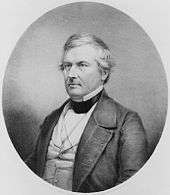
President Polk had pledged not to seek a second term, and with gains in Congress during the 1846 election cycle, the Whigs were hopeful of taking the White House in 1848. The party's perennial candidates, Henry Clay and Daniel Webster, each wanted the nomination, and gained significant support from among their congressional colleagues. Many rank and file Whigs preferred the Mexican War hero, General Zachary Taylor, to head the ticket. Although Taylor was extremely popular, many northerners had qualms about electing a Louisiana slaveholder at a time of sectional tension over whether slavery should be allowed in the territories ceded by Mexico. Taylor's uncertain political views gave others pause—career Army, he had never cast a ballot for president, though he stated that he was a Whig supporter, and some feared they might elect another Tyler, or another Harrison.[47]
With the nomination undecided, Weed maneuvered to send an uncommitted delegation to the 1848 Whig National Convention in Philadelphia, hoping to be a kingmaker in position to place former governor Seward on the ticket, or to get him high national office. He persuaded Fillmore to support an uncommitted ticket, though he did not tell the Buffaloan of his hopes for Seward. Weed was an influential editor, and Fillmore tended to cooperate with him for the greater good of the Whig Party. but Weed had sterner opponents, including Governor Young, who disliked Seward and did not want to see him gain high office.[48]
At the convention, Taylor was nominated on the fourth ballot, to the anger of Clay's supporters and of Conscience Whigs from the Northeast. When order was restored, John A. Collier, a New Yorker and a Weed opponent, addressed the convention. Delegates hung on his every word as he described himself as a Clay partisan; he had voted for Clay on each ballot. He eloquently described the grief of the Clay supporters, frustrated again in their battle to make Clay president. Collier warned of a fatal breach in the party, and stated that only one thing could prevent it: the nomination of Fillmore for vice president, whom he incorrectly depicted as a strong Clay supporter. Fillmore in fact agreed with many of Clay's positions, but did not back him for president and was not in Philadelphia. So delegates did not know this was false, or at least greatly exaggerated, and there was a large reaction in Fillmore's favor. At the time, the presidential candidate did not automatically pick his running mate, and despite the efforts of Taylor's managers to get the nomination for their choice, Abbott Lawrence of Massachusetts, Fillmore became the Whig nominee for vice president on the second ballot.[49]
Weed had sought to get the vice presidential nomination for Seward (who attracted few delegate votes), and Collier had acted to frustrate them in more ways than one, for with the New Yorker Fillmore as vice president, under the political rules of the time, no one from that state could be named to the cabinet. Fillmore was accused of complicity in Collier's actions, but this was never substantiated.[50] Nevertheless, there were sound reasons for the selection of Fillmore, as he was a proven vote-getter from electorally crucial New York, and his track record in Congress and as a candidate showed his devotion to Whig doctrine, allaying fears he might be another Tyler were something to happen to General Taylor. His rivalry with Seward (already known for anti-slavery views and statements) made him more acceptable in the South.[51]
General election campaign
It was customary in 1848 for a candidate for high office not to appear to seek it, so Fillmore did no campaigning, remaining at the comptroller's office in Albany. Thus, the campaign was conducted in the newspapers and with speeches made by surrogates at rallies. The Democrats nominated Michigan Senator Lewis Cass for president, with General William O. Butler his running mate, but it would be a three-way fight as the Free Soil Party, opposed to the spread of slavery, chose former president Van Buren.[52] There was a crisis among the Whigs when Taylor also accepted the presidential nomination of a group of dissident South Carolina Democrats. Fearing that Taylor would be an party apostate like Tyler, Weed in late August scheduled a rally in Albany aimed at electing an uncommitted slate of presidential electors, but Fillmore interceded with the editor, assuring him that Taylor was loyal to the party.[53][54]
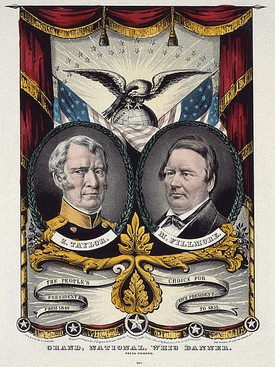
Northerners assumed that Fillmore, hailing from a free state, was an opponent of the spread of slavery. Southerners accused him of being an abolitionist, which he hotly denied.[55] Fillmore responded to one Alabaman in a widely published letter that slavery was an evil, but one that the federal government had no authority over.[53] Taylor and Fillmore corresponded twice in September, with the general happy that the crisis over the South Carolinians was over. Fillmore, for his part, assured his running mate that the electoral prospects for the ticket looked good, especially in the Northeast.[56]
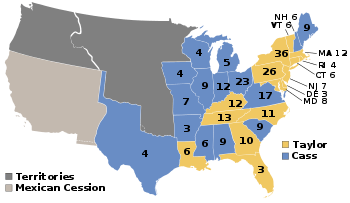
In the end, the Taylor/Fillmore ticket won narrowly, with New York's electoral votes again key to the election.[57] The Whig ticket won the popular vote by 1,360,101 to 1,299,068, and triumphed 163 to 127 in the Electoral College. Minor party candidates took no electoral votes,[58] but the strength of the burgeoning anti-slavery movement was shown by the vote for Van Buren, who though he won no states earned over 291,000 votes and finished second in New York, Vermont and Massachusetts.[59]
Vice president (1849–1850)

Millard Fillmore was sworn in as vice president on March 5, 1849, in the Senate Chamber. As March 4, then the usual Inauguration Day, fell on a Sunday, the swearing-in was postponed until the following day. Fillmore took the oath from Chief Justice Roger B. Taney and in turn swore in the senators beginning their terms, including Seward. Fillmore then went outside with the senators to attend Taylor's inauguration, that night accompanied the president to the inaugural balls, and the following day presided over the confirmation of the cabinet.[60][61]
Fillmore had spent the four months between the election and swearing-in being feted by the New York Whigs and winding up affairs in the comptroller's office. Taylor had written to him promising influence in the new administration, but the president-elect mistakenly thought that the vice president was a cabinet member, which was not true in the 19th century. Fillmore, Seward and Weed had met and come to general agreement on how to divide federal jobs in New York. Seward, once he went to Washington, made friendly contact with Taylor's cabinet nominees, advisers, and the general's brother, and an alliance between the incoming administration and the Weed machine was soon under way behind Fillmore's back. In exchange for support, Seward and Weed were allowed to designate who would fill federal jobs in New York, with Fillmore given far less than had been agreed. When Fillmore, after the inauguration, discovered this, he went to Taylor, but the only result was that the warfare against Fillmore's influence became open. Fillmore supporters like Collier, who had nominated him at the convention, were passed over for candidates backed by Weed, who was triumphant even in Buffalo. This greatly increased the influence of Weed in New York politics, and diminished Fillmore's. According to Rayback, "by mid-1849, Fillmore's situation had become desperate."[62] Despite his lack of influence, he was pestered by office seekers and those seeking to lease or sell a house to him, as there was then no official residence for the vice president. He enjoyed one aspect of his office, due to his lifelong love of learning: he became deeply involved in the administration of the Smithsonian Institution as a member ex officio of its Board of Regents.[63]
Through 1849, the status of slavery in the territories remained unresolved. Taylor advocated the admission of California and of New Mexico (today's New Mexico and Arizona, less the Gadsden Purchase) as states; both would be likely to outlaw slavery. Southerners were surprised to learn the president did not support the introduction of slavery into the new territories, as he believed the institution could not flourish in the arid Southwest. There was anger across party lines in the South, where making the territories free of slavery was considered excluding southerners from part of the national heritage. When Congress met in December 1849, this discord broke out in the election for Speaker, which took weeks and dozens of ballots to resolve as the House divided along sectional lines.[64][65]
Fillmore had not taken Weed's maneuvering lying down, and had fought back by building a network of like-minded Whigs in New York state, with their positions publicized by the establishment of a rival newspaper to Weed's Albany Evening Journal. This was backed by wealthy New Yorkers. All pretense at friendship between Fillmore and Weed vanished in November 1849 when the two happened to meet in New York City, and they exchanged accusations.[66]
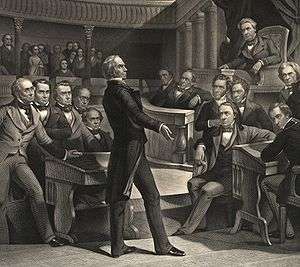
Embattled at home and in Washington, Fillmore at least had the consolation of a prime seat for some of the most momentous and passionate debates in American history, as the vice president is the Senate's presiding officer. The ongoing sectional conflict had already excited much debate when on January 21, 1850, President Taylor sent a special message to Congress urging the admission of California immediately and New Mexico later, and that the Supreme Court settle the boundary dispute whereby the state of Texas claimed much of what is now the state of New Mexico.[67] On January 29, Henry Clay introduced what was called the "Omnibus Bill".[lower-alpha 2] Among other things, the bill would admit California as a free state, organize territorial governments in New Mexico and Utah, and ban the importation of slaves into the District of Columbia for sale and export out of it. It would also toughen the Fugitive Slave Act, as resistance to enforcement in parts of the North was a longtime Southern grievance. Clay's bill provided for the settlement of the Texas-New Mexico boundary dispute; the status of slavery in the territories would be decided by those living there (known as popular sovereignty). Taylor was unenthusiastic about the bill, and it languished in Congress, but Fillmore, after hearing weeks of debate, in May 1850 informed Taylor that if senators divided equally on the bill, he would cast his tie-breaking vote in favor.[2] He did his best to keep the peace among the senators, reminding them of the vice president's power to rule them out of order, but was blamed for failing to maintain it when a physical confrontation between Mississippi's Henry S. Foote and Missouri's Thomas Hart Benton broke out on April 17, with Foote pointing a gun at his colleague as Benton advanced on him.[68]
Presidency (1850–53)
BEP engraved portrait of Fillmore as president
Succession amid crisis
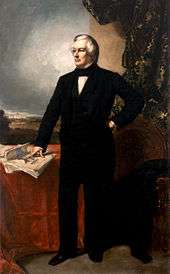
July 4, 1850 was a very hot day in the nation's capital, and President Taylor, who attended Fourth of July ceremonies, refreshed himself, likely with cold milk and cherries. What he consumed probably gave him gastroenteritis, and he died on July 9. Taylor, nicknamed "Old Rough and Ready", had been well over sixty, but his military campaigning in the heat had given him a reputation for toughness, and his death came as a shock to the nation.[69]
On July 10, Fillmore went to the House of Representatives and took the oath as president from William Cranch, chief judge of the federal court for the District of Columbia, and the man who had sworn in President Tyler. The cabinet officers, as was customary when a new president took over, submitted their resignations, expecting Fillmore to refuse, allowing them to continue in office. Fillmore had been marginalized by the cabinet members, and the new president accepted the resignations, though he asked them to stay on for a month, which most refused to do. Fillmore is the only president who succeeded by death or resignation not to retain, at least initially, his predecessor's cabinet. He was already in discussions with Whig leaders, and on July 20 began to send new nominations to the Senate, with the Fillmore cabinet to be led by Webster as Secretary of State. Webster had outraged his Massachusetts constituents by supporting Clay's bill, and with his Senate term to expire in 1851, had no electoral future in his home state. Fillmore appointed his old law partner, Nathan Hall, as Postmaster General, a cabinet position that controlled many patronage appointments.[70] The new department heads were mostly supporters of the Compromise, as was Fillmore.[71]
The brief pause from politics out of national grief at Taylor's death had not abated the crisis. Texas had attempted to assert its authority in New Mexico territory, and the state's governor, Peter H. Bell, had sent belligerent letters to President Taylor.[72] Fillmore received another such after becoming president. He reinforced federal troops in the area, and warned Bell to keep the peace.[71] By July 31, Clay's bill was effectively dead, as all the significant provisions had been deleted by amendment other than the organization of Utah Territory—one wag put it that the Mormons were the only remaining passengers on the Omnibus. Illinois Senator Stephen Douglas then stepped to the fore, with Clay's agreement, proposing to break the Omnibus into individual bills that could be passed piecemeal.[73] Fillmore endorsed this strategy, with the Omnibus to become (as it proved) five bills.[2]
Fillmore sent a special message to Congress on August 6, 1850, disclosing the letter from Governor Bell and his reply, warning that armed Texans would be viewed as intruders, and urging Congress to defuse sectional tensions by passing the compromise. Without the Great Triumvirate of Calhoun, Webster and Clay who had long dominated the Senate,[lower-alpha 3] Douglas and others led that body towards the administration-backed package of bills. Each bill passed the Senate with the support of the section that wanted it, plus a small number of members who were determined to see all the bills passed. The battle then moved to the House, which had a Northern majority because of population. Most contentious was the Fugitive Slave Bill, whose provisions were anathema to abolitionists. Fillmore applied pressure to get Northern Whigs to abstain rather than oppose, including New Yorkers—threatening to kill the renomination of Congressman Abraham Schermerhorn of Rochester, whose constituents included Frederick Douglass, if he voted against the bill. Through the legislative process, various changes were made, including the setting of a boundary between New Mexico Territory and Texas—the state would be given a payment to settle any claims. California was admitted as a free state, the District slave trade was ended, and the final status of slavery in New Mexico and Utah would be settled later. Fillmore signed the bills as they reached his desk, holding the Fugitive Slave Bill for two days until he received a favorable opinion as to its constitutionality from the new Attorney General, John J. Crittenden. Although some Northerners were unhappy at the Fugitive Slave Act, relief was widespread, as was the hope this would settle the slavery question.[74][75]
Domestic affairs
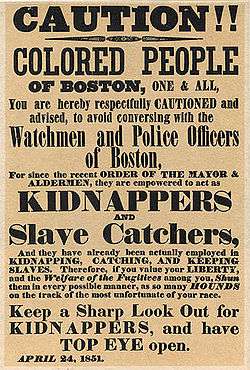
The Fugitive Slave Act continued to be contentious after its enactment: Southerners complained bitterly about any slackness, but enforcement was highly offensive to many Northerners. Abolitionists recited the inequities of the law: it punished severely any aid to an escaped slave, and if captured, he had no due process and could not testify before a magistrate who would be paid more for deciding he was a slave than for deciding he was not. Nevertheless, Fillmore believed himself bound by his oath as president and by the bargain made in the Compromise to enforce the Fugitive Slave Act. He did so even though some prosecutions or attempts to return slaves ended badly for the government, with acquittals or the slave taken from federal custody and to freedom by a Boston mob. Such cases were widely publicized North and South, and inflamed passions in both places, undermining the good feeling that had followed the Compromise.[76]
In September 1850, Fillmore appointed Mormon leader Brigham Young as the first governor of Utah Territory.[77] In gratitude, Young named the first territorial capital "Fillmore" and the surrounding county "Millard".[78]
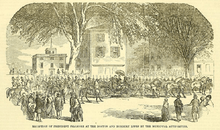
A longtime supporter of national infrastructure development, Fillmore signed bills to subsidize the Illinois Central railroad from Chicago to Mobile, and for a canal at Sault Ste. Marie. The 1851 completion of the Erie Railroad in New York caused Fillmore and his cabinet to ride the first train from New York City to the shores of Lake Erie, in company with many other politicians and dignitaries. Fillmore made many speeches along the way from the train's rear platform, urging acceptance of the Compromise, and afterwards went on a tour of New England with his Southern cabinet members. Although Fillmore urged Congress to authorize a transcontinental railroad, it did not do so until a decade later.[79]
Fillmore appointed one justice of the Supreme Court of the United States, and made four appointments to United States District Courts, including that of his law partner and cabinet officer, Nathan Hall, to the federal district court in Buffalo.[80] When Supreme Court Justice Levi Woodbury died in September 1851 with the Senate not in session, Fillmore made a recess appointment of Benjamin Robbins Curtis to the high court. In December, Congress having convened, Fillmore made formal nomination of Curtis, who was confirmed. Justice Curtis would, in 1857, dissent in the slavery case of Dred Scott v. Sandford, and resign as a matter of principle.[81]
Justice John McKinley's death in 1852 led to repeated, fruitless attempts by the president to fill the vacancy. The Senate took no action on the nomination of New Orleans attorney Edward A. Bradford. Fillmore's second choice, George Edmund Badger, asked that his nomination be withdrawn. Senator-elect Judah P. Benjamin declined to serve. The nomination of William C. Micou, a New Orleans lawyer recommended by Benjamin, was not acted on by the Senate. The vacancy was finally filled after Fillmore's term, when President Franklin Pierce nominated John Archibald Campbell, who was confirmed by the Senate.[82]
Foreign affairs
Fillmore oversaw two highly competent Secretaries of State, Webster, and after the New Englander's 1852 death, Edward Everett, looking over their shoulders and making all major decisions.[83] The president was particularly active in Asia and the Pacific, especially with regard to Japan, which at this time still prohibited nearly all foreign contact. American merchants and shipowners wanted Japan "opened up" for trade. This would allow not only commerce, but permit American ships to call there for food and water, and in emergencies without being punished. They were concerned that American sailors cast away on the Japanese coast were imprisoned as criminals.[84] Fillmore and Webster dispatched Commodore Matthew C. Perry to open Japan to relations with the outside world, by force if necessary. Though Perry did not reach Japan until after the end of Fillmore's term, Fillmore ordered the Perry Expedition, and its success is to his credit.[84]
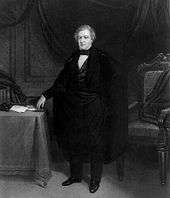
Fillmore was also a staunch opponent of European influence in Hawaii. France under Napoleon III attempted to annex Hawaii, but backed down after Fillmore issued a strongly worded message warning that "the United States would not stand for any such action."[84] American merchants saw in the British opening of China to trade an example of the "benefits of new trade markets."[84] Taylor had pressed Portugal for payment of American claims dating as far back as the War of 1812, and had refused offers of arbitration; Fillmore gained a favorable settlement.[85]
Fillmore had difficulties regarding Cuba; many Southerners hoped to see the island part of the U.S. as slave territory: Cuba was a colony of Spain where slavery was practiced.[84] Venezuelan adventurer Narciso López recruited Americans for three "filibustering" expeditions to Cuba, in the hope of overthrowing Spanish rule there. After the second attempt in 1850, López and several of his followers were indicted for breach of the Neutrality Act, but were quickly acquitted by friendly Southern juries.[84] The final López expedition ended with his execution by the Spanish, who put a number of Americans before the firing squad, including the nephew of Attorney General Crittenden. This resulted in riots against the Spanish in New Orleans, causing their consul to flee; historian Elbert E. Smith, who wrote of the Taylor and Fillmore presidencies, suggested that Fillmore could have had war against Spain had he wanted it. Instead, Fillmore, Webster and the Spanish worked out a number of face-saving measures that settled the crisis without armed conflict. Many Southerners, including Whigs, supported the filibusters, and Fillmore's response helped divide his party as the 1852 election approached.[86]
Another issue that came up during Fillmore's presidency was the arrival of Lajos Kossuth, the exiled leader of a failed Hungarian revolution against Austria. Kossuth wanted the U.S. to recognize Hungary's independence. Many Americans were sympathetic to the Hungarian rebels, especially recent German immigrants, who were now coming to the U.S. in large numbers and had become a major political force. Kossuth was feted by Congress, and Fillmore allowed a White House meeting after receiving word that Kossuth would not try to politicize it. In spite of his promise, Kossuth made a speech promoting his cause. The American enthusiasm for Kossuth petered out, and he departed for Europe; Fillmore refused to change American policy, remaining neutral.[87]
| The Fillmore Cabinet | ||
|---|---|---|
| Office | Name | Term |
| President | Millard Fillmore | 1850–1853 |
| Vice President | None | 1850–1853 |
| Secretary of State | Daniel Webster | 1850–1852 |
| Edward Everett | 1852–1853 | |
| Secretary of Treasury | Thomas Corwin | 1850–1853 |
| Secretary of War | Charles M. Conrad | 1850–1853 |
| Attorney General | Reverdy Johnson | 1850 |
| John J. Crittenden | 1850–1853 | |
| Postmaster General | Nathan K. Hall | 1850–1852 |
| Samuel D. Hubbard | 1852–1853 | |
| Secretary of the Navy | William A. Graham | 1850–1852 |
| John P. Kennedy | 1852–1853 | |
| Secretary of the Interior | Thomas M. T. McKennan | 1850 |
| Alexander H. H. Stuart | 1850–1853 | |
Election of 1852 and completion of term
As the election of 1852 approached, Fillmore remained undecided whether to run for a full term as president. Secretary Webster had long coveted the presidency and, though past seventy, planned a final attempt to gain the White House. Fillmore was sympathetic to the ambitions of his longtime friend, but though he issued a letter in late 1851 stating that he did not seek a full term, was reluctant to entirely rule it out, fearing the party would be captured by the Sewardites. Thus, approaching the national convention in Baltimore, to be held in June 1852, the major candidates were Fillmore, Webster and General Scott. Weed and Seward backed Scott; in late May, the Democrats nominated former New Hampshire senator Franklin Pierce, who had been out of national politics for nearly a decade before 1852, but whose profile had risen as a result of his military service in the Mexican War. The nomination of Pierce, a northerner who was sympathetic to the southern view on slavery, united the Democrats and meant the Whig candidate would face an uphill battle to gain the presidency.[88]
Fillmore was by then unpopular with northern Whigs for signing and enforcing the Fugitive Slave Act, but had considerable support from the South, where he was seen as the only candidate capable of uniting the party. Once the convention passed a party platform endorsing the Compromise as a final settlement of the slavery question, Fillmore was willing to withdraw, but found that many of his supporters could not accept Webster and his action would nominate Scott. Thus, the convention deadlocked, and this persisted through Saturday, June 19, when a total of 46 ballots had been taken; the convention adjourned until Monday. Party leaders proposed a deal to both Fillmore and Webster: if the secretary could increase his vote total over the next several ballots, enough Fillmore supporters would go along to put him over the top; if he could not, Webster would withdraw in favor of Fillmore. The president quickly agreed, but Webster did not do so until Monday morning. On the 48th ballot, Webster delegates began to defect to Scott, and the general gained the nomination on the 53rd ballot. Webster was far more unhappy at the outcome than was Fillmore, who refused the secretary's resignation. Bereft of the votes of much of the South, and also of Northerners who depended on peaceful intersectional trade, Scott was easily beaten by Pierce in November. Smith suggested that the Whigs might have done much better with Fillmore.[89]
The final months of Fillmore's term were uneventful. Webster died in October 1852, but during the final illness, Fillmore effectively acted as his own Secretary of State without incident, and Everett stepped competently into Webster's shoes. Fillmore intended to lecture Congress on the slavery question in his final annual message in December, but was talked out of it by his cabinet, and he contented himself with pointing out the prosperity of the nation and expressing gratitude for the opportunity to serve it. There was little discussion of slavery during the lame duck session of Congress, and Fillmore left office on March 4, 1853, succeeded by Pierce.[90]
Post-presidency
Tragedy and political turmoil (1853–1855)
Fillmore was the first president to return to private life without being independently wealthy or in possession of a landed estate, and, with no pension to anticipate, was unsure how he would make a living consistent with the dignity of his former office. His friend, Judge Hall, assured him that it would be proper for him to practice law in the higher courts of New York, and Fillmore intended to do so.[91] The Fillmores had planned a tour of the South after leaving the White House, but Abigail caught a cold at President Pierce's inauguration, developed pneumonia, and died in Washington on March 30, 1853. A saddened Fillmore returned to Buffalo for the burial.[92] The fact that he was in mourning limited his social activities, allowing him to make ends meet on the income from his investments.[93] He was not yet done with tragedy: on July 26, 1854, his only daughter Mary died of cholera.[94]
The former president ended his seclusion in early 1854, as debate over Senator Douglas' Kansas-Nebraska Bill embroiled the nation. This would open the northern portion of the Louisiana Purchase to settlement, including slavery, and would end the northern limit on slavery under the Missouri Compromise of 1820. Fillmore decided on an ostensibly nonpolitical national tour, hoping to rally disaffected Whig politicians to preserve the Union and back a run for president, for he retained many supporters. This occupied much of the late winter and spring of 1854. Fillmore made public appearances opening railroads and visiting the grave of Senator Clay, but met behind the scenes with politicians.[95]
Such a comeback could not be under the auspices of the Whig Party, with its remnants divided by the Kansas-Nebraska legislation (which passed wth the support of Pierce). Many northern foes of slavery, such as Seward, gravitated towards a new party, the Republicans, but Fillmore saw no home for himself there. There was in the early 1850s considerable hostility towards immigrants, especially Catholics, who had recently arrived in the United States in large numbers, and a number of nativist organizations, including the Order of the Star Spangled Banner, sprang up in response. By 1854, the Order had morphed into the American Party, which became known as the Know Nothings, for in its early days, members were sworn to hold private its internal deliberations, and if asked were to say they knew nothing about them.[96] Fillmore was not himself anti-Catholic – his daughter Mary had attended a girls' Catholic boarding school for a year[97] and he contributed to the construction of St. Joseph Cathedral in Buffalo[98] but many from Fillmore's National Whig faction had joined the Know Nothings by 1854, and influenced the organization to take up causes besides nativism.[99] The success of the Know Nothings in the 1854 midterm elections, in which they won in several Northeastern states and showed strength in the South encouraged Fillmore, and on January 1, 1855, he sent a letter for publication, warning against immigrant influence in American elections, and soon thereafter joined the Order of the Star Spangled Banner.[100]
Later that year, Fillmore went abroad, stating publicly that as he lacked office, he might as well travel. The trip was at the advice of political friends, who felt that by touring, he would avoid involvement in the contentious issues of the day, and he spent over a year, from March 1855 to June 1856, in Europe and the Middle East. Queen Victoria is said to have pronounced the ex-president the handsomest man she had ever seen, while his presence in the gallery of the House of Commons at the same time as Van Buren excited a comment from MP John Bright.[101] Fillmore was offered an honorary Doctor of Civil Law (D.C.L.) degree by the University of Oxford. Fillmore turned down the honor, explaining that he had neither the "literary nor scientific attainment" to justify the degree.[102] He is also quoted as having explained that he "lacked the benefit of a classical education" and could not, therefore, understand the Latin text of the diploma, adding that he believed "no man should accept a degree he cannot read."[103] Another possibility is that Fillmore refused the degree in order to escape the heckling and taunting to which Oxford students typically subjected the recipients of such honors.[104][lower-alpha 4]
While in Europe, he also met with Pope Pius IX in Rome. Fillmore carefully weighed the political advantages and disadvantages of meeting with Pius, and nearly withdrew from the meeting when told he would have to kneel and kiss the pope's hand. To avoid this, Pius remained seated throughout the meeting.[106][107]
1856 campaign
Fillmore's allies were in full control of the American Party, and they arranged for him to get its presidential nomination while he was in Europe. As Fillmore's running mate, the Know Nothing convention chose Andrew Jackson Donelson of Kentucky, nephew by marriage and onetime ward of President Jackson. Fillmore returned in June, arriving to a huge reception in New York City. He progressed across the state to Buffalo, speaking at a series of welcomes. At these celebrations, he made addresses ostensibly in thanks for his reception, without violating the tradition that it was considered office-seeking for a presidential hopeful to speak publicly. In his addresses, Fillmore warned that electing the Republican candidate, former California senator John C. Frémont, who had no support in the South, would divide the Union and lead to civil war. He rarely spoke about the immigration question, and focused on the sectional conflict. He differed less with the Democratic candidate, former Pennsylvania senator James Buchanan; the two men had similar views on slavery.[108][109]
Once Fillmore was back home in Buffalo, he had no excuse to make speeches, and his campaign stagnated through the summer and fall of 1856. Political fixers who had been Whigs, such as Weed, tended to join the Republican Party, and the Know Nothings lacked experience at selling anything but nativism. Accordingly, Fillmore's pro-Union stance mostly went unheard. Although the South was friendly towards Fillmore, they feared a Frémont victory would lead to secession, and many sympathetic to Fillmore moved into the Buchanan camp lest the anti-Frémont vote be split, which might elect the Republican.[110] Scarry suggested that the events of 1856, including the conflict in Kansas Territory and the caning of Charles Sumner on the floor of the Senate polarized the nation, making Fillmore's moderate stance obsolete.[111]

On Election Day, Buchanan won 1,836,072 votes (45.3%) and 174 electoral votes to Frémont's 1,342,345 votes (33.1%) and 114 electoral votes. Fillmore and Donelson finished third, winning 873,053 votes (21.6%) and carrying the state of Maryland and its 8 electoral votes.[lower-alpha 5] The American Party ticket narrowly lost in several southern states, and a change of less than 8,000 votes in Louisiana, Kentucky, and Tennessee would have thrown the election to the House of Representatives, where the sectional divide would have made the outcome uncertain.[112]
Historian Allan Nevins wrote that Fillmore was not a Know Nothing or a nativist. He was out of the country when the nomination came and had not been consulted about running. Furthermore, "By no spoken or written word had he indicated a subscription to American tenets."[113] He sought national unity and felt the American Party was the "only hope of forming a truly national party, which shall ignore this constant and distracting agitation of slavery."[114]
Later life
With his defeat in 1856, Fillmore deemed his political career at an end. He again felt inhibited from returning to the practice of law. But his financial worries were removed when on February 10, 1858, Fillmore married Caroline McIntosh, a wealthy widow. Their combined wealth allowed them to purchase a large house on Niagara Square in Buffalo, where they lived for the remainder of Millard Fillmore's life.[115] There, the Fillmores devoted themselves to entertaining and philanthropy, according to Smith, "they generously supported almost every conceivable cause".[116] Among these was the Buffalo Historical Society and the Buffalo General Hospital, which he helped found.[117]

In the election of 1860, Fillmore voted for Senator Douglas, the nominee of the northern Democrats. After the vote, in which the Republican candidate, former Illinois representative Abraham Lincoln was elected, many sought out Fillmore's views but he refused to take any part in the secession crisis that followed, feeling that he lacked influence.[118] He opposed Buchanan's inaction as states left the Union, writing that while the federal government could not coerce a state, those advocating secession should simply be regarded as traitors. When Lincoln came to Buffalo en route to his inauguration, Fillmore led the committee selected to receive the president-elect, hosted him at his mansion, and took him to church. Once war came, Fillmore supported Lincoln in his efforts to preserve the Union.[119] He commanded the Union Continentals, a corps of home guards of males over the age of 45 from the upstate New York area. The Continentals trained to defend the Buffalo area in the event of a Confederate attack. They performed military drill and ceremonial functions at parades, funerals, and other events. The Union Continentals guarded Lincoln's funeral train in Buffalo. They continued operations after the war, and Fillmore remained active with them almost until his death.[120][121]
Despite Fillmore's zeal in the war effort, he was attacked in many newspapers when he gave a speech in early 1864 calling for magnanimity towards the South at war's end, and counting the heavy cost, financial and in blood, of the war. The Lincoln administration saw this as an attack on it, that could not be tolerated in an election year, and Fillmore was called a Copperhead and even a traitor. This led to lasting ill-felling against Fillmore in many circles.[122] In the 1864 presidential election Fillmore supported Democratic candidate George B. McClellan for the presidency, believing that the Democratic Party's plan for immediate cessation of fighting and allowing the seceded states to return with slavery intact was the best possibility for restoring the Union.[123]
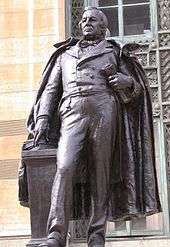
After Lincoln's assassination in April 1865, black ink was thrown on Fillmore's house as it was not draped in mourning like others, though he was apparently out of town at the time and put black drapes in the windows once he returned. Although he retained his position as Buffalo's leading citizen and was among those selected to escort the body when Lincoln's funeral train passed through Buffalo, there was still anger against him for his wartime positions.[124] Fillmore supported President Andrew Johnson's Reconstruction policies, feeling that the nation needed to be reconciled as quickly as possible.[125] Most of his time was devoted to his civic activities. He aided Buffalo in becoming the third American city, after Boston and Philadelphia, to have a permanent art gallery with the Buffalo Fine Arts Academy.[126]
Fillmore stayed in good health almost to the end, but suffered a stroke in February 1874, and died after a second one on March 8. Two days later, he was buried at Forest Lawn Cemetery in Buffalo after a funeral procession of hundreds of notables;[127] the U.S. Senate sent three of its members to honor its former president, including Lincoln's first vice president, Maine's Hannibal Hamlin.[128]
Legacy and historical view

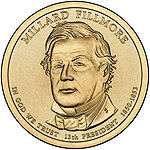
According to his biographer, Scarry: "No president of the United States ... has suffered as much ridicule as Millard Fillmore".[129] He ascribed much of the abuse to a tendency to denigrate the presidents who served in the years just prior to the Civil War as lacking in leadership. For example, later president Harry S Truman "characterized Fillmore as a weak, trivial thumb-twaddler who would do nothing to offend anyone", responsible in part for the war.[130] Anna Prior, writing in The Wall Street Journal in 2010, stated that Fillmore's very name connotes mediocrity.[131] Another Fillmore biographer, Finkelman, commented, "on the central issues of the age his vision was myopic and his legacy is worse ... in the end, Fillmore was always on the wrong side of the great moral and political issues".[132] Rayback, however, applauded "the warmth and wisdom with which he had defended the Union".[133]
Although Fillmore has become something of a cult figure as America's most forgettable chief executive, Smith found Fillmore to be, "a conscientious president" who chose to honor his oath of office and enforce the Fugitive Slave Act, rather than govern based on his personal preferences.[134] Paul G. Calabresi and Christopher S. Yoo, in their study of presidential power, deemed Fillmore "a faithful executor of the laws of the United States—for good and for ill".[135] But, according to Smith, the enforcement of the Act has given Fillmore an undeserved pro-southern reputation. Additionally, Fillmore's place in history has suffered because "even those who give him high marks for his support of the compromise have done so almost grudgingly, probably because of his Know-Nothing candidacy in 1856".[136] Smith argued that Fillmore's association with the Know Nothings looks far worse in retrospect than it did at the time, and that the former president was not motivated by nativism in his candidacy.[137]
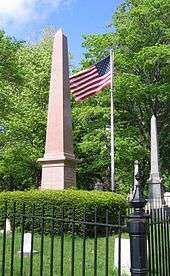
Benson Lee Grayson suggested that the Fillmore administration's ability to avoid potential problems is too often overlooked. Fillmore's constant attention to Mexico avoided a resumption of the war and laid the groundwork for the Gadsden Treaty during Pierce's presidency.[138] Meanwhile, the Fillmore administration resolved a serious dispute with Portugal left over from the Taylor administration,[139] smoothed over a disagreement with Peru over guano islands, and peacefully resolved disputes with Britain, France, and Spain over Cuba. All of these crises were resolved without the United States going to war or losing face.[140] Grayson also applauded Fillmore's firm stand against Texas's ambitions in New Mexico during the 1850 crisis.[141] Fred I. Greenstein and Dale Anderson praised Fillmore for his resoluteness in his early months in office, noting that Fillmore "is typically described as stolid, bland, and conventional, but such terms underestimate the forcefulness evinced by his handling of the Texas–New Mexico border crisis, his decision to replace Taylor’s entire cabinet, and his effectiveness in advancing the Compromise of 1850".[142]
Millard Fillmore, with his wife Abigail, established the first White House library.[97] There are a number of remembrances of Millard Fillmore; his East Aurora house still stands, and sites are dedicated to him at his birthplace (where a replica log cabin was dedicated in 1963 by the Millard Fillmore Memorial Association) and boyhood home.[143] A statue of Fillmore stands outside Buffalo City Hall.[144] At the University of Buffalo, which he helped found, Millard Fillmore Academic Center and Millard Fillmore College bear his name.[145][146] On February 18, 2010, the United States Mint released the thirteenth coin in the Presidential $1 Coin Program, bearing Fillmore's likeness.[131][147]
According to the assessment of Fillmore by the Miller Center of Public Affairs at the University of Virginia:
Any assessment of a President who served a century and a half ago must be refracted through a consideration of the interesting times in which he lived. Fillmore's political career encompassed the tortuous course toward the two-party system that we know today. The Whigs were not cohesive enough to survive the slavery imbroglio, while parties like the Anti-Masonics and Know-Nothings were too extremist. When, as President, Fillmore sided with proslavery elements in ordering enforcement of the Fugitive Slave Law, he all but guaranteed that he would be the last Whig President. The first modern two-party system of Whigs and Democrats had succeeded only in dividing the nation in two by the 1850s, and seven years later, the election of the first Republican President, Abraham Lincoln, would guarantee civil war.[148]
Plaques to Fillmore
-

Fillmore's East Aurora house was moved off Main Street
-

The house is designated a National Historic Landmark
-

The DAR placed this plaque on the house in 1931
-

A memorial to Fillmore on the gate surrounding his plot in Buffalo
-

Detail of the Fillmore obelisk in Buffalo.]
See also
- List of Presidents of the United States, sortable by previous experience
- U.S. Presidents on U.S. postage stamps
- Mallard Fillmore, a fictive, politically conservative journalist duck
Notes
- ↑ The original log cabin was demolished in 1852, but in 1965, the Millard Fillmore Memorial Association using materials from a similar cabin, constructed a replica, which is located in Fillmore Glen State Park in Moravia.[1]
- ↑ For it carried all the proposals as passengers, the origination of that political term.
- ↑ With, by then, Calhoun dead, Webster as Secretary of State, and Clay recovering from his exertions on behalf of the bill at Newport, Rhode Island.
- ↑ In fact, Fillmore had been awarded an honorary LL.D. from Geneva College in 1850; he accepted, even though its text was in Latin.[105]
- ↑ Fillmore thus became the first former president to receive electoral votes, a distinction he would be joined in by Grover Cleveland (1892) and Theodore Roosevelt (1912).
References
- ↑ "Presidential Places: Millard Fillmore". American Presidents: Life Portraits. C-SPAN. Archived from the original on February 24, 2015. Retrieved 28 August 2016.
- 1 2 3 4 5 6 7 American National Biography.
- 1 2 Bahles, Gerald (2010). "Millard Fillmore: Life Before the Presidency". American President: Miller Center of Public Affairs. Retrieved October 19, 2016.
- ↑ Rayback, 191–97.
- ↑ Doty, Lockwood Lyon (1876). A History of Livingston County, New York. Geneseo, New York: Edward L. Doty. pp. 673–676. OCLC 14246825.
- ↑ Rayback, 224–58.
- ↑ Rayback, 258–308.
- 1 2 Finkelman, p. 5.
- ↑ Scarry, 528–34.
- ↑ Finkelman, pp. 5–6.
- ↑ Scarry, 128–34.
- ↑ Scarry, 672.
- ↑ Smith, p. 45.
- ↑ Finkelman, pp. 12–13.
- ↑ Rayback, 314, 750–810.
- ↑ Skinner, Roger Sherman (1830). The New-York State Register for 1830. New York, NY: Clayton & Van Norden. p. 361.
- ↑ Fillmore, Millard; Severance, Frank H. (1907). Millard Fillmore papers. 2. Buffalo, NY: Buffalo Historical Society. p. 151.
- ↑ Scarry, 936–940, 993–999.
- ↑ Rayback, 878–905.
- ↑ Finkelman, p. 13.
- ↑ Rayback, 1261.
- ↑ Scarry, 999.
- ↑ Finkelman, p. 14.
- ↑ Scarry, 1079.
- ↑ Rayback, 1495–1508.
- 1 2 Rayback, 1556–1679.
- ↑ Scarry, 1326–1331.
- ↑ Scarry, 1356–1361.
- ↑ Scarry, 1891.
- ↑ Rayback, 1950–1957.
- ↑ Rayback, 1957–2186.
- ↑ Scarry, 1729–1776.
- ↑ Scarry, 1766.
- ↑ Scarry, 1776–1820.
- ↑ Rayback, 2417.
- ↑ Rayback, 2425–2471.
- ↑ Rayback, 2471–2486.
- ↑ Rayback, 2486–2536.
- ↑ Rayback, 2536–2562.
- ↑ Finkelman, p. 24.
- ↑ Finkelman, pp. 23–24.
- ↑ Finkelman, pp. 35, 152.
- ↑ Rayback, 2620.
- ↑ Rayback, 2735–2763.
- ↑ Finkelman, p. 25.
- ↑ Rayback, 2769–2799.
- ↑ Finkelman, pp. 43–45.
- ↑ Rayback, pp. 2902–2955.
- ↑ Rayback, 2981–2994.
- ↑ Rayback, 3001–3008.
- ↑ Finkelman, pp. 47–49.
- ↑ Scarry, 3138–3150.
- 1 2 Finkelman, p. 53.
- ↑ Scarry, 3188–3245.
- ↑ Finkelman, p. 51.
- ↑ Scarry, 3245–3258.
- ↑ Rayback, 3090.
- ↑ Scarry, 3283.
- ↑ Finkelman, pp. 51–52.
- ↑ Snyder, pp. 39–41.
- ↑ Congressional Globe, March 5 and 6, 1849
- ↑ Rayback, 3101–3307.
- ↑ Smith, pp. 160–162.
- ↑ Rayback, 3307–3367.
- ↑ Smith, pp. 93–94.
- ↑ Rayback, 3367–3399.
- ↑ Scarry, 3445–3467.
- ↑ Smith, pp. 138–139, 163–165.
- ↑ Finkelman, p. 1.
- ↑ Finkelman, pp. 72–77.
- 1 2 Greenstein & Anderson, p. 48.
- ↑ Smith, pp. 152–157.
- ↑ Smith.
- ↑ Scarry, 4025–4102.
- ↑ Finkelman, pp. 82–85.
- ↑ Smith, pp. 208–213.
- ↑ "The American Franchise". American President, An Online Reference Resource. Miller Center of Public Affairs, University of Virginia. Retrieved 2008-03-13.
- ↑ Winder, Michael Kent (2007). Presidents and Prophets: The Story of America's Presidents and the LDS Church. American Fork, UT: Covenant Communications. ISBN 978-1-59811-452-2.
- ↑ Smith, pp. 199–200.
- ↑ "Biographical Dictionary of the Federal Judiciary". Washington, DC: Federal Judicial Center. Retrieved March 4, 2012. searches run from page, "select research categories" then check "court type" and "nominating president", then select U.S. District Courts (or U.S. Circuit Courts) and also Millard Fillmore.
- ↑ Smith, pp. 218, 247.
- ↑ "Supreme Court Nominations, 1789-Present". Senate.gov. U.S. Senate. Retrieved 2014-09-08.
- ↑ Smith, p. 233.
- 1 2 3 4 5 6 Bahles, Gerald (2010). "Millard Fillmore: Foreign Affairs". American President: Miller Center of Public Affairs. Retrieved October 19, 2016.
- ↑ Smith, pp. 72–73.
- ↑ Smith, p. 228.
- ↑ Smith, pp. 230–232.
- ↑ Smith, pp. 238–244.
- ↑ Smith, pp. 244–247.
- ↑ Smith, pp. 247–249.
- ↑ Rayback, 5726–5745.
- ↑ Rayback, 5858–5865.
- ↑ Rayback, 6025–6031.
- ↑ Millard Fillmore, author, Frank H. Severance, editor, Millard Fillmore Papers, Volume X, 1907, p. 25.
- ↑ Rayback, 6038–6057.
- ↑ Rayback, 5900–5966.
- 1 2 "First Lady Biography: Abigail Fillmore". The National First Ladies' Library. Retrieved 2013-12-19.
- ↑ Kunz Goldman, Mary (16 February 2014). "Walking in footsteps of Buffalo presidents". The Buffalo News.
- ↑ Rayback, 5952–5959.
- ↑ Smith, pp. 252–253.
- ↑ Rayback, 6191–6234.
- ↑ "Millard Fillmore". Internet Public Library. Retrieved 2013-12-20.
- ↑ "Millard Fillmore". EBSCO Industries, Inc. Retrieved 2013-12-21.
- ↑ Scarry, Robert J. (2001). Millard Fillmore. Jefferson, NC: McFarland & Company, Inc. p. 270. ISBN 978-0-7864-0869-6.
- ↑ "Honorary Degree Recipients, 1827–1913" (PDF). Hobart and William Smith Colleges Library. Geneva, NY: Hobart and William Smith Colleges. 2013. p. 39.
- ↑ Rayback, 6248.
- ↑ Finkelman, p. 132.
- ↑ Scarry, 6650–6699.
- ↑ Rayback, 6326–6411.
- ↑ Rayback, 6398–6458.
- ↑ Scarry, 6918.
- ↑ Rayback, 6458–6473.
- ↑ Allan Nevins, Ordeal of the Union: A House Dividing 1852-1857 (1947) 2:467. Nevins states that Fillmore was not publicly a member but historian William Gienapp says he was a secret member. William E. Gienapp, The Origins of the Republican Party, 1852-1856 (1987) p 260n
- ↑ Tyler Anbinder. "Fillmore, Millard" American National Biography Online (2000)
- ↑ Rayback, 6476–6518.
- ↑ Smith, pp. 254–255.
- ↑ https://www.kaleidahealth.org/bgmc/visitors/history.asp
- ↑ Scarry, 7285–7297.
- ↑ Rayback, 6578–6600.
- ↑ Proceedings, Volumes 23–37. Buffalo Historical Society. 1885. p. 72.
- ↑ Smith, pp. 264–265.
- ↑ Rayback, 6667–6706.
- ↑ Neil A. Hamilton, Presidents: A Biographical Dictionary, 2010, p. 111.
- ↑ Rayback, 6706.
- ↑ Finkelman, p. 154.
- ↑ Rayback, 6783–6790.
- ↑ Rayback, 6930–6946.
- ↑ Scarry, 8118.
- ↑ Scarry, 8151.
- ↑ Scarry, 8157–8161.
- 1 2 Anna Prior (February 18, 2010). "No Joke: Buffalo and Moravia Duke It Out Over Millard Fillmore". The Wall Street Journal. Retrieved December 1, 2016. (subscription required (help)).
- ↑ Finkelman, p. 137.
- ↑ Rayback, 6953.
- ↑ Smith, pp. 257, 260.
- ↑ Calabresi & Yoo, p. 151.
- ↑ Smith, pp. 260–261.
- ↑ Smith, p. 254.
- ↑ Grayson, p. 120.
- ↑ Grayson, p. 83.
- ↑ Grayson, pp. 103–109.
- ↑ Smith, pp. 288–289.
- ↑ Greenstein & Anderson, p. 55.
- ↑ Rayback, 8151–8157.
- ↑ Scarry, 6946–6953.
- ↑ https://www.millardfillmorecollege.com/
- ↑ http://www.buffalo.edu/facilities/planning-design/building-profiles/north-campus.host.html/content/shared/university/page-content/facilities/filmor.detail.html
- ↑ Smith, Lester (ed.). "Millard Fillmore Presidential $1 Coin — 13th President, 1850–1853". United States Mint. Retrieved December 1, 2016.
- ↑ Miller Center of Public Affairs, University of Virginia. "Millard Fillmore: Impact and Legacy". Retrieved November 19, 2016.
Works cited
- Anbinder, Tyler (February 2000). "Fillmore, Millard". American National Biography Online. Retrieved September 27, 2016. (subscription required (help)).
- Calabresi, Steven G.; Yoo, Christopher S. (2008). The Unitary Executive: Presidential Power from Washington to Bush. Yale University Press. ISBN 978-0-300-12126-1.
- Finkelman, Paul (2011). Millard Fillmore. The American Presidents. New York: Times Books. ISBN 978-0-8050-8715-4.
- Grayson, Benson Lee (1981). The Unknown President: The Administration of Millard Fillmore. Washington, D.C.: University Press of America. ISBN 978-0-8191-1457-0.
- Greenstein, Fred I.; Anderson, Dale (2013). Presidents and the Dissolution of the Union: Leadership Style from Polk to Lincoln. Princeton University Press. ISBN 978-1-4008-4641-2.
- Rayback, Robert J. (2015) [1959]. Millard Fillmore: Biography of a President (Kindle ed.). Pickle Partners Publishing.
- Scarry, Robert J. (2001). Millard Fillmore (Kindle ed.). Jefferson NC: McFarland & Co., Inc. ISBN 978-1-4766-1398-7.
- Smith, Elbert B. (1988). The Presidencies of Zachary Taylor & Millard Fillmore'. The American Presidency. University Press of Kansas. ISBN 978-0-7006-0362-6.
- Snyder, Charles M. (1975). The Lady and the President: The Letters of Dorothea Dix and Millard Fillmore. University Press of Kentucky. ISBN 978-0-8131-1332-6.
Further reading
- Anbinder, Tyler. Nativism and Slavery: The Northern Know Nothings and the Politics of the 1850s (1992), covers 1856 campaign.
- Brinkley, Alan; Dyer, Davis, eds. (2004). The American Presidency. pp. 145–151. ISBN 978-0-618-38273-6.
- Overdyke, W. Darrell (1950). The Know-Nothing Party in the South. Baton Rouge: Louisiana State University Press. OCLC 1377033.
- Silbey, Joel H. (2014). A Companion to the Antebellum Presidents 1837-1861. Wiley. pp. 309–44.
- Van Deusen, Glyndon G. "Fillmore, Millard". Encyclopedia Americana. Archived from the original on May 10, 2004. Retrieved 2007-05-09.
External links
| Wikisource has original works written by or about: Millard Fillmore |
| Wikiquote has quotations related to: Millard Fillmore |
| Wikimedia Commons has media related to Millard Fillmore. |
- United States Congress. "Millard Fillmore (id: F000115)". Biographical Directory of the United States Congress.
- Millard Fillmore: A Resource Guide from the Library of Congress
- White House Biography
- Biography by Appleton's and Stanley L. Klos
- Finding Aid to Millard Fillmore Letters, 1829-1859 at the New York State Library
- Works by Millard Fillmore at Project Gutenberg
- Works by or about Millard Fillmore at Internet Archive
- Works by Millard Fillmore at LibriVox (public domain audiobooks)

- Millard Fillmore: A bibliography by The Buffalo History Museum
- Millard Fillmore House, Buffalo, NY
- Millard and Abigail Fillmore House, East Aurora, NY
- Millard Fillmore at Encyclopedia American: The American Presidency
- Essays on Fillmore and each member of his cabinet and First Lady
- "Life Portrait of Millard Fillmore", from C-SPAN's American Presidents: Life Portraits, June 11, 1999
.jpg)


